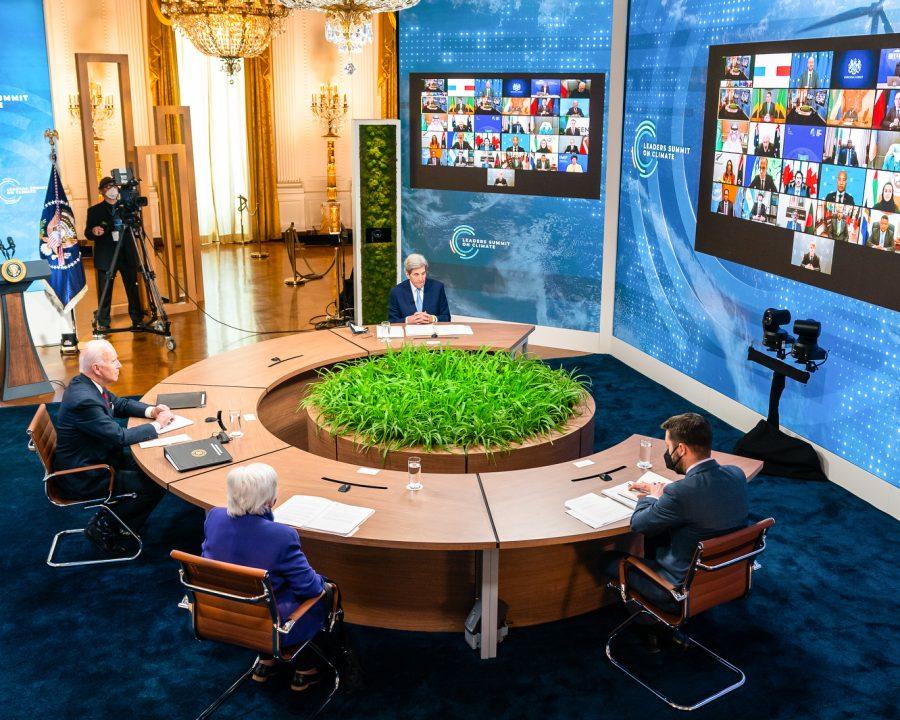President Joe Biden hosted a virtual Earth Day summit with 40 world leaders on April 22 and 23. The president announced his plans for the U.S. to cut greenhouse gas emissions by 50 percent by 2030 and the U.S.’ rejoining of the Paris Climate Agreement.
The 40 world leaders in attendance included: Brazilian President Jair Bolsanaro, Canadian Prime Minister Justin Trudeau, Chinese President Xi Jinping, French President Emmanuel Macron, German Chancellor Angela Merkel, Indian Prime Minister Narendra Modi, Russian President Vladimir Putin, New Zealand President Jacinda Arden, Japanese Prime Minister Yoshihide Suga, and British Prime Minister Boris Johnson, among many other world leaders.
President Biden announced on Earth Day that the U.S. is committed to reducing greenhouse gas emissions by 50-52 percent below 2005 levels by 2030, a steep increase from the 26-28 percent emissions cut agreed on in 2015 during the Obama administration.
Many countries committed to cutting their greenhouse gas emissions by 2030 as well.
Brazilian President Jair Bolsanaro promised to end illegal deforestation in the country by 2030 and to become carbon neutral by 2050.
Japanese Prime Minister Yoshihide Suga committed to Japan cutting emissions by 46 percent by 2030 (compared to 2013 levels).
Prime Minister Justin Trudeau committed to Canada cutting emissions 40-45 percent below 2005 levels by 2030.
Prime Minister Narendra Modi of India reconfirmed India’s promise to install 450 gigawatts of renewable energy by 2030 but did not give a new target for cutting emissions. He also announced an India-U.S. Climate and Clean Energy Agenda Partnership by 2030.
President Vladimir Putin announced that the country of Russia would significantly cut emissions but did not give a specific target.
Chinese President Xi Jinping reconfirmed China’s promise to peak emissions by 2030 and become carbon neutral by 2060. Currently, China is the largest emitter of greenhouse gases, coming before the U.S. and India.
South Korean President Moon Jae In announced that Korea will no longer finance coal-fired power plants overseas.
Many leaders also commended President Biden for hosting the summit. During the Trump administration, the U.S. exited the Paris Agreement and stopped federal efforts to reduce emissions.
German Chancellor Angela Merkel stated, “I’m delighted to see that the United States is back to work together with us in climate politics, because there can be no doubt about the world needing your contribution.”
President Biden spoke at the summit, stating, “This is the decisive decade. This is the decade that we must make decisions to avoid the worst consequences of the climate crisis.”
According to Voice of America, “Many experts say the 2020s are a make-or-break decade.” Global temperatures have increased 1.1 degrees Celsius since 1880 which may sound like a small amount, but is a big increase from average global temperatures and is a major concern for climate scientists. Leaders all across the globe have committed to limiting the global temperature increase to below 2 degrees Celsius.
VOA reports that according to the Intergovernmental Panel on Climate Change, “global emissions need to fall by about 45 percent by 2030. By 2050, they need to reach net-zero, where emissions are canceled out by removing planet-warming carbon dioxide from the atmosphere.”
David Waskow, International Climate Initiative director at the World Resources Institute said that the summit has been “an opportunity for the U.S. to come back onto the scene to show it is taking climate change seriously.

